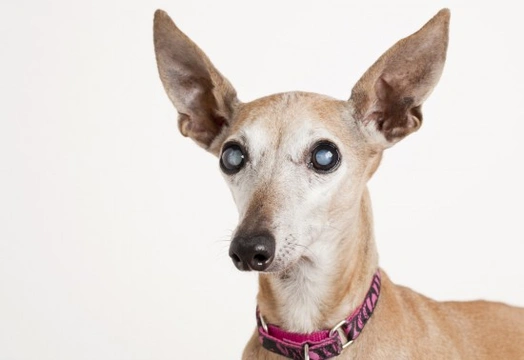
Canine eye problems commonly confused with cataracts
If your dog appears to be developing cloudy eyes, losing their vision or displaying some kind of opacity or obstruction within the eye itself, the layman dog owner often concludes that they are likely viewing the onset of cataracts, particularly in older dogs. While cataracts are overall the most commonly seen progressive eye condition of dogs, cataracts are by no means the only possible or most likely diagnosis for developing eye problems.
In this article, we will examine some of the most common eye conditions in dogs that can appear similar to cataracts, which might be presented as the ultimate diagnosis by your vet.
Cataracts
Starting from the top, cataracts cause the lens of the eye to take on a cloudy appearance, which in turn can lead to loss of vision. Cataracts are the most common cause of blindness in the dog, but they can be treated with surgery. Cataracts tend to develop most commonly in mature and elderly dogs, or due to a genetic predisposition to the condition, or as a side effect of diabetes.
Progressive retinal atrophy
Progressive retinal atrophy or PRA is a genetically inherited condition caused by the degeneration of the retinas of the eyes, and affects both eyes at once. The time that the disease takes to develop can vary from case to case, but the disease is always progressive, and will ultimately lead to blindness.
Glaucoma
Glaucoma is essentially caused by an unusual build-up of pressure within the eye, and may present itself as a side effect of other conditions. Some breeds and types of dogs are particularly prone to the condition, including the Basset Hound, Poodle and Cocker Spaniel.
If the drainage angle of the eyes’ tear ducts are not positioned properly, this can lead to the build-up of pressure seen with glaucoma, and the associated loss of vision. Glaucoma itself is not a painful condition.
Corneal ulcers
Corneal ulcers are sometimes known as ulcerative keratitis, and involve the loss of the cornea’s outer layer and accompanying inflammation. Corneal ulcers in dogs are very common, and are also rather painful. They may be accompanied by squinting, overproduction of tears, and general signs of irritation in the eye of the dog. Superficial corneal ulcers are usually fully treatable with antibiotics, pain medications and sometimes, topical treatments. Superficial corneal ulcers will often even heal on their own within the course of a week or two, but deeper ulcers will require surgical treatment.
Lenticular sclerosis
Lenticular sclerosis, also sometimes known as nuclear sclerosis, is a common diagnosis in dogs that have reached maturity at around age seven or eight. This condition is quite possibly the condition most likely to be mistaken for cataracts, as it leads to a cloudy, hazy appearance of the lens of the eyes, which is usually grey or blue-ish in colour. Both eyes are affected simultaneously. While the condition may appear to be fairly pronounced, it is not painful and very rarely affects vision. Currently, no treatment or correction is available for the condition.
Corneal dystrophy
Corneal dystrophy in dogs is a hereditary condition, and one that is relatively rare. It is caused by the build-up of cholesterol crystals and lipids over the lens of the eye, which presents as an obstruction of the lens that may be fatty and mucky-looking, or may take the appearance of fine lines or crystals. Either one eye or both may be affected, and the condition is usually slow to progress. During the early stages of the development of the condition, vision is rarely affected, but as it grows more progressive, loss of vision may occur.
The condition can usually be treated by means of corneal transplant surgery, which is a complex and specialised procedure usually performed by a veterinary ophthalmologist.
Retinal dysplasia
Retinal dysplasiais a non-progressive disease that affects the retina. It is sometimes caused or triggered by external factors, such as a vitamin deficiency or a viral infection, but it is generally genetically inherited. Retinal dysplasia is distinctive in appearance to cataracts, as the obstruction caused over the eye takes on the appearance of folds or clumps within the tissue, rather than a general cloudiness. These tissue formations are known as “rosettes.”
Cataracts or glaucoma may also accompany retinal dysplasia, or develop as a result of the condition, further complicating matters. Retinal dysplasia may affect just one eye or both eyes at once. While it can affect the vision, it is not painful, and is not a progressive condition. Retinal dysplasia is not currently treatable, but it is generally manageable to live with.
Get your dog checked out
If you are concerned that something unusual is going on with your dog’s eyes, get them checked out by the vet as soon as possible. Many canine eye conditions are treatable, and catching them early can help to preserve your dog’s vision.
Even with conditions that cannot be cured, it is important to know what you are dealing with, and how the condition will progress. This will allow you to take steps to accommodate for your dog’s changes in vision, and make their life as easy as possible.



